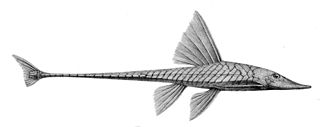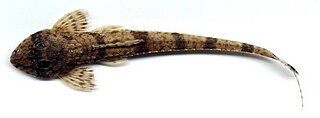
Rineloricaria is a genus of freshwater tropical catfish belonging to the family Loricariidae. They are commonly called whiptail catfish because of the long filament that grows out of the tip of the caudal fin that is characteristic of the genus. With the exception of R. altipinnis from Panama, they are native to the rivers of northern and central South America. Some species are regularly seen in the aquarium trade.

Farlowella is a genus of fish in the family Loricariidae native to South America. This genus is broadly distributed in Amazon, Orinoco, Paraná and coastal rivers of the Guyana Shield. It is absent from the Pacific slope of the Andes and from the coastal rivers of the Brazilian Shield. Many of these species are kept in aquariums. This genus has a unique body shape that resembles a thin stick of wood. The body is slender and elongate, often with a pronounced rostrum and a brownish color with two lateral dark stripes beginning at the tip of the rostrum, passing over the eyes and ending at the tail, which are periodically interrupted on the caudal peduncle.

Sturisoma is a genus of armored catfishes native to Central and South America.

Loricaria is a genus of armored catfish native to South America.

Dasyloricaria is a genus of armored catfishes native to Central and South America. The distribution of these species includes the northwestern South America on the Pacific slope of Colombia and Panama. Its distribution is restricted to the Pacific slope of the Andes, which is a unique pattern of distribution within the subfamily.

Spatuloricaria is a genus of armored catfishes native to South America and Panama.

Chaetostoma, also known as the bristlemouth catfish, is a genus of suckermouth armored catfishes native to South America with one species, C. fischeri, extending into Panama. Most species inhabit flowing rivers in the lower Andes and its foothills. Some species are kept in unheated aquaria.
Chaetostoma platyrhynchus is a species of catfish in the family Loricariidae. It is native to South America, where it occurs in the Caquetá River basin in Colombia. The species reaches 9.5 cm in total length. The species is known to be of disputed classification and spelling.
Loricaria birindellii is a species of catfish in the family Loricariidae. It is native to South America, where it occurs in the Curuá River, a tributary of the Iriri River, which is itself a tributary of the Xingu River, with its type locality being listed as the municipality of Altamira in the state of Pará in Brazil. The species reaches 36.5 cm (14.4 in) in total length, can weigh up to at least 118.2 g (4.17 oz), and is believed to be a facultative air-breather.
Loricaria luciae, sometimes known as Lucia's whiptail, is a species of catfish in the family Loricariidae. It is native to South America, where it occurs in the Paraguay River basin in Argentina, Bolivia, Brazil, and Paraguay, ranging south to the Paraguay's confluence with the Paraná River. It is typically found in habitats with flowing water, ranging in size from arroyos to large rivers, where it generally occurs at a depth of less than 1.5 m in environments with soft substrates. It is sometimes seen in riffles and blackwater areas. The species reaches 18.9 cm (7.4 in) in standard length and is believed to be a facultative air-breather. Its specific epithet, luciae, honors Lúcia H. Rapp Py-Daniel of the National Institute of Amazonian Research for her contributions to loricariid taxonomy and systematics.
Loricaria lundbergi is a species of catfish in the family Loricariidae. It is native to South America, where it occurs in the Rio Negro drainage basin in Brazil and Venezuela. It is typically found in blackwater habitats. An analysis of the stomach contents of a single individual found evidence of feeding on insect larvae, including those of the family Chironomidae, as well as sand and detritus. The species reaches 13.8 cm in standard length and is believed to be a facultative air-breather. Its specific epithet, lundbergi, honors John G. Lundberg of the Academy of Natural Sciences of Drexel University for his contributions to Neotropical ichthyology.
Loricaria pumila is a species of catfish in the family Loricariidae. It is native to South America, being known from Brazil, where it occurs in the Amazon River basin, near the mouths of the Tapajós and the Pará River, including the lower Tocantins River. It is reportedly typically found at depths between 3 and 29 m and distances of 15 to 1,500 m from the shoreline, in environments characterized by a substrate of silt and organic detritus. An analysis of the stomach contents of a single individual found evidence of feeding on insects and aquatic insect larvae, as well as sand and detritus. The species reaches 8.1 cm (3.2 in) in standard length and is believed to be a facultative air-breather. Its specific epithet, pumila, is derived from Latin and means "dwarf", referring to the small adult size of the species.
Rineloricaria jurupari is a species of catfish in the family Loricariidae. It is native to South America, where it occurs in the upper Vaupés River, which is part of the Amazon River basin, in Colombia. The species reaches 9.45 cm in standard length. It was described in 2018 by Alejandro Londoño-Burbano and Alexander Urbano-Bonilla on the basis of its distinctive morphology and coloration. FishBase does not yet list this species.
Spatuloricaria terracanticum is a species of catfish in the family Loricariidae. It is native to South America, where it occurs in the Orinoco basin in Colombia. It is typically found in environments at elevations of 197 to 350 m above sea level with moderate slopes, turbid to slightly clear water, a conductivity of 30 to 302 μS/cm, oxygen concentration of 1.6 to 7.6 mg/L, oxygen saturation of 22.5% to 98.8%, pH of between 6.4 and 8.2, temperatures of 22.5 to 28.6 °C, and substrates composed of rocks and sand. The species reaches 28.6 cm in standard length.
Farlowella mitoupibo is a species of catfish in the family Loricariidae. It is native to South America, where it occurs in the upper Guaviare River, which is part of the Orinoco basin in Colombia. The species reaches at least 20.96 cm in standard length. It was described in 2016 by Gustavo A. Ballen, Alexander Urbano-Bonilla, and Jhon Zamudio. Its specific name, mitoupibo, is derived from the Guahibo name for the species. FishBase does not yet list this species.
Sturisoma graffini is a species of catfish in the family Loricariidae. It is native to South America, where it occurs in the Madre de Dios River basin in Peru. It was described in 2018 by Alejandro Londoño-Burbano of the Federal University of Rio de Janeiro on the basis of its distinctive coloration and morphology. Its specific name, graffini, honors the singer and evolutionary biologist Greg Graffin. FishBase does not yet list this species.
Sturisoma reisi is a species of catfish in the family Loricariidae. It is native to South America, where it occurs in the Cautário River, the Guaporé River, the Ji-Paraná River, the Mamoré River, and the Sotério River in the Madeira River basin in Bolivia and Brazil. It was described in 2022 by Alejandro Londoño-Burbano and Marcelo Ribeiro de Britto of the Federal University of Rio de Janeiro on the basis of distinctive genetic and morphological characteristics.
Sturisomatichthys guaitipan is a species of catfish in the family Loricariidae. It is native to South America, where it occurs in the upper and middle Magdalena River basin in Colombia. The species was described in 2019 by Alejandro Londoño-Burbano and Roberto E. Reis as part of a taxonomic revision of the genus Sturisomatichthys.
Sturisomatichthys reinae is a species of catfish in the family Loricariidae. It is native to South America, where it occurs in the Baudó River basin in Colombia. The species was described in 2019 by Alejandro Londoño-Burbano and Roberto E. Reis as part of a taxonomic revision of the genus Sturisomatichthys.
Sturisomatichthys varii is a species of catfish in the family Loricariidae. It is native to South America, where it occurs in the San Juan River basin in Colombia. The species was described in 2019 by Alejandro Londoño-Burbano and Roberto E. Reis as part of a taxonomic revision of the genus Sturisomatichthys.






